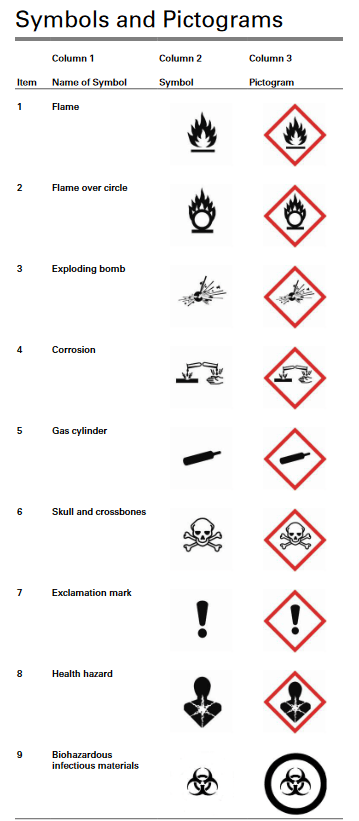GHS Pictogram Meanings
By: Alison Senyi, SENIOR PRODUCT SAFETY SPECIALIST
You’re probably familiar with some of the following pictograms:
- exploding bomb pictogram
- skull and crossbones pictogram
- health hazard pictogram
- exclamation mark pictogram
But do you know what these hazard pictograms mean? If your company is responsible for manufacturing, importing or distributing hazardous chemicals, then here’s what you need to know.
In this article, we’ll cover one of the major changes in GHS regulations governing chemical hazards, examples of GHS pictogram meanings, and how Dell Tech can assist you with GHS compliance. To get started, let’s have a quick reminder on GHS.
GHS: A Quick Refresher
GHS stands for the Globally Harmonized System of Classification and Labelling of Chemicals. Introduced by the United Nations, it standardizes the classification and labelling of chemical products worldwide. It also standardizes labelling elements such as precautionary statements and signal words for products.
Though it is a worldwide system, this does not mean that safety data sheets can be used universally around the world. Dell Tech specializes in authoring SDSs for Canada, United States and combined US/CAN for both countries.
Read more about what GHS stands for, or continue reading about changes in GHS regulations, including the amendments to symbols and pictograms.
The change in GHS regulations
With the change in regulations from WHMIS 1988 to WHMIS 2015, the word ‘Pictogram’ is being used rather than ‘Symbol’. Although the word Symbol is still in play, when we are talking about SDSs and labels, we say Pictogram. This change in verbiage has been causing some confusion. What causes even more confusion, is that one pictogram could have countless classifications. This is something Canadians have always had to deal with as the same happened with the older WHMIS 1988 symbols, where one symbol could have various meanings.
Below you will find the GHS Symbols and GHS Pictograms that Canada has adopted. But what are these GHS pictogram meanings?
What do these pictograms mean?
Let’s walk through a couple of examples to better understand how one GHS pictogram can have multiple meanings.
For the first example, we’ll look at the flammable symbol. This can be used for three different classifications under the Flammable Liquids category alone:
- extremely flammable liquids;
- highly flammable liquids; and
- flammable liquids and vapors.
All three of these have different endpoints, and yet the same symbol is being used. This is why it is important to have the correct precautionary statements in section 2 of your safety data sheets. This helps advise the users which hazard class the product belongs to. It is of utmost importance to provide this information so that the product can be stored and used safely within the workplace.
The same issue happens with the new health hazard pictogram. This one pictogram can signal a number of hazard classes, including:
- carcinogen
- germ cell mutagen
- reproductive toxin
- STOT single and repeated exposure
In other words, there are multiple classifications that use this particular pictogram. What is important, regardless of which classification is being indicated, is that you are using the proper GHS pictogram and placing the appropriate hazard statement onto both your safety data sheet and GHS label.
What Dell Tech can do to help with understanding GHS Pictograms
If you have any questions regarding GHS symbol/pictogram meanings or requirements, do not hesitate to contact us. The Product Safety team at Dell Tech can help you convert your older MSDS into a current safety data sheet that uses the appropriate hazard symbols. We’ll ensure that your product is compliant, and has an accurate GHS label.
Dell Tech has provided professional, confidential consulting services to the specialty chemical
industry in Canada, the USA, Europe, and Asia for the last 40 years.
Contact us today for more information.








